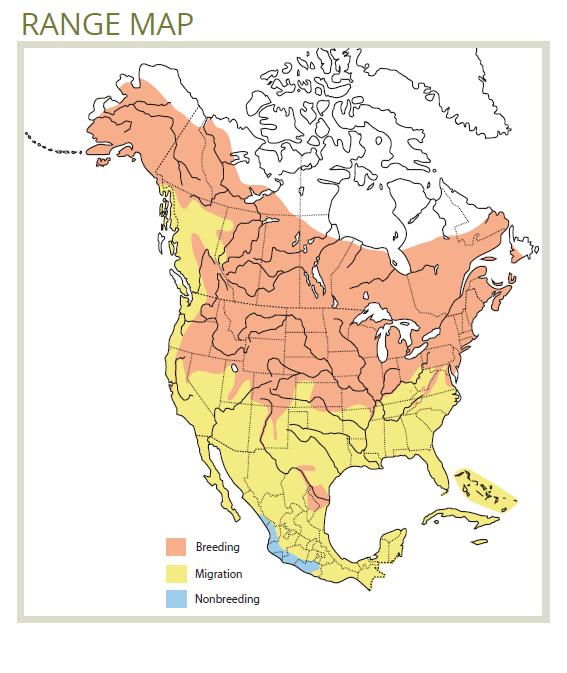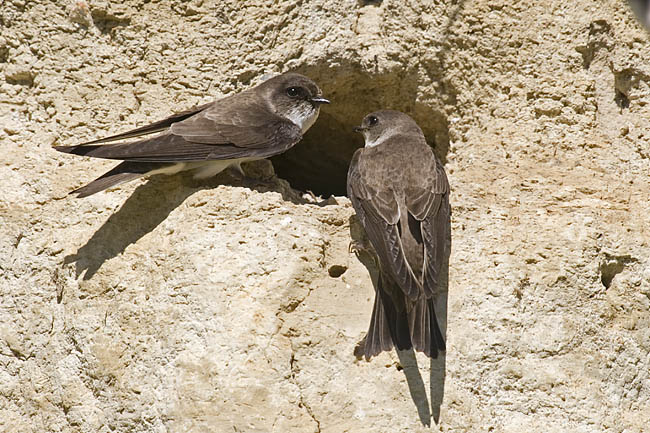These fast-flying acrobats hunt for insects mid-air over open areas, and nest in burrows they dig in the sandy sides of stream banks (and sand piles, if available).
Bank Swallow
(Riparia riparia)
Habitat Ecology
- The Bank Swallow is a fast-flying bird that breeds in colonies of 10 to 2,000 nests.1
- They excavate nesting burrows in sandy, eroded riparian banks, large sand piles and road cuts.1
- Features with vertical/nearly vertical faces and firm substrate (i.e., can be tunnelled without collapsing) are most suitable for excavation. See Stand-level Recommendations.
- Bank Swallows forage in open areas, including above riparian (and sometimes upland) woodlands.1 They typically avoid dense forests and are expected to forage over recent burns and harvest blocks.2
- In forested landscapes, Bank Swallows are mostly likely to occur in riparian areas where sandy soils occur (e.g., glacial outwash), which may be indicated by the presence of pine.3,4 They forage in nearby open habitats, however the presence of sandy, eroded banks for nesting is the most important factor in determining their presence.

Response to Forest Management
- Nesting Bank Swallows are vulnerable to mortality from riparian banks collapsing, flooding, or being otherwise damaged (e.g., by road-building).1
- Erosion control measures used during road construction can cause nesting habitat loss or direct mortality when materials (e.g., rock walls) are placed in front of nest sites.5
- Insecticide use is a concern due to effects on food supply, which may affect the Bank Swallow’s reproductive success or survival.6,7
Stand-level Recommendations
- Planned stream crossings should be inspected for nest entrances on stream banks prior to road construction. Where large colonies (>10 pairs) are located, a 50-m buffer should be established within which high-intensity activities (road-building, landings, stream crossings) should be avoided.2,8
- Monitoring should be frequent in the spring (May-June) as swallows may establish a colony over several days.9
- Riparian buffers should be maintained, and streams not requiring buffers should be checked for eroded, sandy banks which could be potentially used by nesting Bank Swallows. Where these features are found, voluntary buffers are recommended to avoid damaging current or future nesting sites.
- Bank Swallows may excavate nests in sand piles or road cuts, risking mortality if disturbance is planned during the breeding season. The following steps are recommended for operators to manage this risk:9,10
- Evaluate suitability for excavation: If you insert a 4–5” pipe and dig out the sand inside, does the cavity collapse when the pipe is removed? If no, Bank Swallows may excavate burrows on vertical faces of this feature.
- If vertical faces are present (e.g., on a sand pile), collapse them using equipment during the breeding season.
- If the feature is firm enough to be excavated, and vertical faces cannot be collapsed, it should be tightly covered with tarps if left exposed for >48 hours during the breeding season.11
- Note that mist nets and other thin netting should not be used as swallows may become tangled in them. Operators should instead use canvas or other textiles (e.g., silage tarps).2,9
Landscape-level Recommendations
- Areas with streams/rivers and open areas (meadows, bogs, open woodland, cutover areas, and recent burns) have a higher likelihood of containing Bank Swallow colonies, particularly in areas characterized by sandy soils. Surveying planned road right of ways and avoiding creek crossings in areas with open, sandy banks is an important planning step.
- In operating areas known or expected to contain Bank Swallows, careful attention during road-building and stream-crossing is encouraged to avoid impacting stream flow and natural hydrologic processes.2
References
- Garrison, B. A. 1999. Bank Swallow (Riparia riparia), version 2.0. in The Birds of North America (Rodewald, P. G., ed.) Cornell Lab of Ornithology, Ithaca, New York, USA. Available online: https://doi.org/10.2173/bna.414
- Falconer, M. 2018. Personal Communication. March 22, 2018.
- ABMI. 2017. Bank Swallow (Riparia riparia). ABMI Species Website, version 4.1 Available online: http://species.abmi.ca/pages/species/birds/BankSwallow.html
- Howie, R. 2015. Bank Swallow. in The Atlas of the Breeding Birds of British Columbia, 2008-2012 (Davidson, P. J. A., Cannings, R. J., Couturier, A. R., Lepage, D. & Di Corrado, C. M., eds.) Bird Studies Canada, Delta, B.C. Available online: http://www.birdatlas.bc.ca/accounts/speciesaccount.jsp?sp=BKSW&lang=en
- COSEWIC. 2013. COSEWIC Assessment and Status Report on the Bank Swallow Riparia riparia in Canada. Committee on the Status of Endangered Wildlife in Canada, Ottawa. ix + 48 pp. Available online: www.registrelep-sararegistry.gc.ca/default_e.cfm
- Poulin, B., Lefebvre, G. & Paz, L. 2010. Red flag for green spray: adverse trophic effects of Bti on breeding birds. Journal of Applied Ecology 47: 884–889.
- Kirk, D. A., Lindsay, K. E. & Brook, R. W. 2011. Risk of agricultural practices and habitat change to farmland birds. Avian Conservation and Ecology 6: 5.
- OMNR. 2010. Forest Management Guide for Conserving Biodiversity at the Stand and Site Scales – Background and Rationale for Direction. Queen’s Printer for Ontario, Toronto, ON. 575 pp.
- OMNRF. 2017. Best Management Practices for the Protection, Creation and Maintenance of Bank Swallow Habitat in Ontario. Ontario Ministry of Natural Resources and Forestry. Queen’s Printer for Ontario, 37 pp.
- Bonar, R. 2018. Personal communication. April 6, 2018
- Ministry of Transportation. 2017. MTO Best Management Practices for Species at Risk Protection During Maintenance Activities. Ontario Ministry of Transportation, Policy and Planning Division, Transportation Planning Branch – Environmental Policy Office. Available online: http://www.raqsa.mto.gov.on.ca/techpubs/eps.nsf/0/1867bb469de0c3fa852580…$FILE/MTO BMP Manual for SAR Protection During Maintenance Jan 2017 Final ACC.pdf








